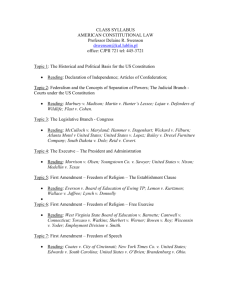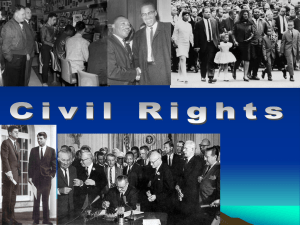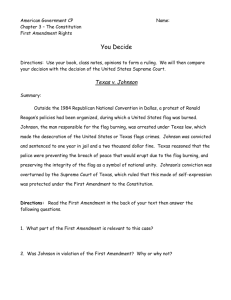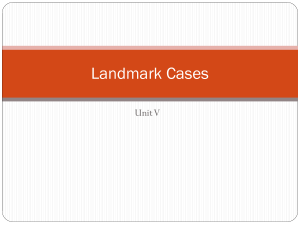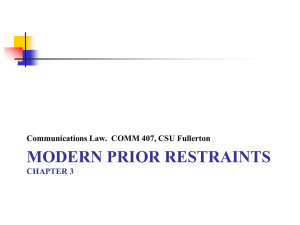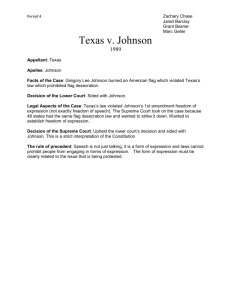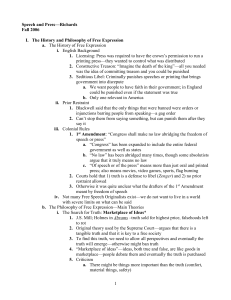The First Amendment
advertisement
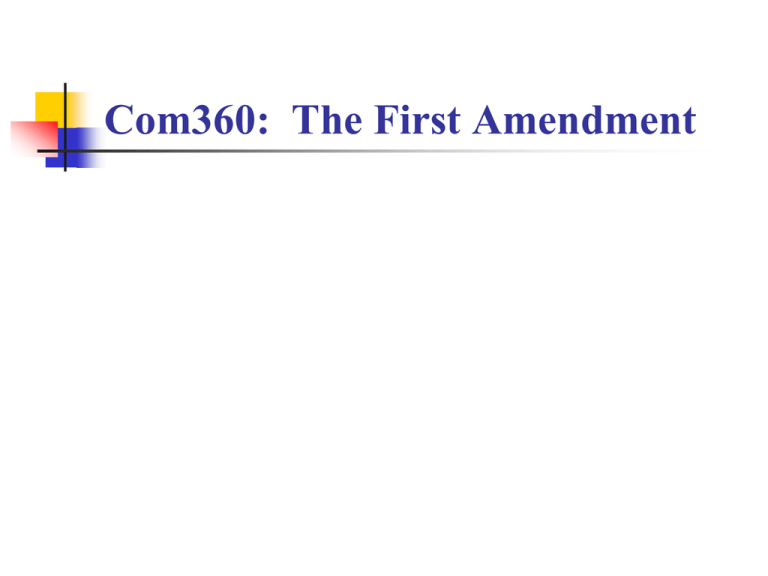
Com360: The First Amendment Freedom of Speech Free speech is a means to an end: discovering the best idea possible. (social reasons) Free speech is also an end itself: the desire for free expression, self-fulfillment. (individualistic reasons) The Case for Free Speech Discovery of Truth: The pursuit of political truth through competition of ideas. A means of political participation. Check on Government: The restraint on tyranny, corruption, and ineptitude. Social Stability: The facilitation of majority rule. The marketplace theory The best test of truth is the power of the thought to get itself accepted in the competition of the market (Oliver Wendell Holmes) Freedom to think as you will and to speak as you think are means indispensable to the discovery and spread of political truth (Justice Louis Brandeis) Free expression and human dignity The First Amendment serves not only the needs of the polity but also those of the human spirit—a spirit that demands selfexpression (Thurgood Marshall) Self-fulfillment Pleasure, Gratification Respect First Amendment Congress shall make no law respecting an establishment of religion, or prohibiting the free exercise thereof, or abridging the freedom of speech, or of the press; or the right of the peaceably to assemble, and to petition the Government for a redress of grievances. The First Amendment Ratified in 1791 as additional safeguards against central government Originally applied only to federal government Expanded to the states in Gitlow v. New York (1925). Decision based on the Equal Protection Clause of the 14th Amendment (Incorporation Doctrine): No state shall… deny to any person within its jurisdiction the equal protection of the laws. What is Speech All forms of expressions: The actual spoken/written communication Symbolic speech / Expressive conduct to convey a message Symbolic speech: Cohen v. California (1971) Facts:A 19-year-old man expressed his opposition to the Vietnam War by wearing a jacket emblazoned with "FUCK THE DRAFT. STOP THE WAR" He was convicted under a California statute that prohibits "maliciously and willfully disturbing the peace and quiet of any neighborhood or person [by] offensive conduct." Cohen v. California (1971) Question Presented: Did California's statute violate freedom of expression rights? Conclusion: Yes. The expletive, while provocative, was not directed toward anyone; The Court recognized that "one man's vulgarity is another's lyric." In doing so, the Court protected two elements of speech: the emotive (the expression of emotion) and the cognitive (the expression of ideas). What about burning draft cards? United States v. O’Brien 1968 Not protected by the First Amendment: A sufficiently important governmental interest in regulating the nonspeech element (the card assists in administrative procedures). Symbolic speech R.A.V. v. City of St. Paul 1992 Displays containing abusive invective, no matter how vicious or severe, are permissible as long as they don’t provoke violence etc. Flag burning Texas v. Johnson (1989) During the protests against the Republican National Convention in Dallas in 1984 Gregory Johnson set on fire a national flag. He was convicted under Texas criminal statute making: it is a criminal offense to… desecrate… a state or national flag.” He was sentenced to one year in prison and a fine of $2,000. Texas v. Johnson (1989) The Supreme Court was divided 5-4 in the decision but ruled for Johnson. It ruled that the desecration was “expressive conduct.” Thus, Texas statute prohibited expressing ideas, not desecration and thus was not permissible. United States v. Eichman 1990. The Federal Flag Protection Act adopted in response to Texas v. Johnson is unconstitutional under the first Amendment. Chaplinsky v. New Hampshire (1942) Facts: Chaplinsky called a city marshal a "Goddamned racketeer" and "a damned fascist" in a public place. He was convicted under a state law for violating a breach of the peace. Question: Does the statute violate his freedom of speech rights? Conclusion: No. Some forms of expression-among them obscenity and fighting words--do not convey ideas and thus are not subject to First Amendment protection. Prior Restraint Near v. Minnesota (1931) Prior Restraint (censorship): Prohibition of speech before the fact The Case of Near v. Minnesota: Any system of prior restraints of expression comes to this Court bearing a heavy presumption against its constitutional validity Prior Restraint: other methods of censorship : Licensing (excessive requirements/unequal) Informal Coercion (warnings) Financial burdens (e.g., tax on certain publications, extra fees, limiting payments, etc.) Punishment After the Fact More likely than Prior Restraint, but still very unusual. Will be covered in greater detail in later chapters Compelled Speech Media Access Compelled Financial Support (e.g., union dues) Attribution Requirements Time, Place, Manner Restrictions Standards of judicial review Minimum Scrutiny Rational Standard / Legitimate Interest: requires the law to be reasonably related to a legitimate state interest. Intermediate Scrutiny Important governmental interest: requires the law to be substantially related to an important government interest Strict Scrutiny Compelling governmental interest: the law must be narrowly tailored to address a compelling state interest. Strict Scrutiny The highest standard of judicial review. To pass strict scrutiny, the law or policy: 1. must be justified by a compelling governmental interest 2. must be narrowly tailored to achieve that goal or interest 3. must be the least restrictive means for achieving that interest
